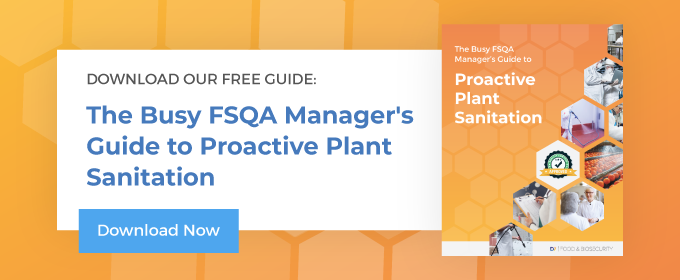Bacterial resistance in the food industry is a challenge that all FSQA managers face. When microorganisms become resistant to the sanitizers that are used to remove them, the products become less effective over time. This increases the risk of bacterial contamination in a food processing facility because the resistant bacteria that are left behind are able to multiply on surfaces. Taking a proactive approach by using various types of chemicals can help reduce the risk of bacterial resistance.
How Bacteria Resistance Happens
Understanding why bacteria resistance happens and how you can avoid it in your facility will help reduce the risk of a future outbreak.
Changes in Cell Structure
Some bacteria can become resistant to disinfectants by adapting the structure of their cell walls to allow in smaller amounts of biocides. This mechanism is particularly common in biofilms due to the protection that the extracellular matrix provides. Biofilms are more resistant than free bacteria because the outer layers of the biofilm are less permeable than the walls of individual cells. This is one reason that biofilms are able to be so persistent after they have formed.
Efflux Pumping
All cells, including bacteria, have efflux pumps that transport compounds out of them. Some bacteria become resistant to disinfectants by activating efflux pumps to excrete compounds that are toxic to the cells, reducing the efficacy of the chemicals intended to destroy the bacteria.
Genetic Resistance
Disinfectants that were previously effective can become less so when bacteria develops a genetic resistance. As the bacteria adapts to the disinfectant and the genes mutate, the chemicals become less effective. This mechanism for resistance is particularly concerning because it can also cause resistance to antibiotics or other compounds. This sometimes occurs with exposure to low concentrations of disinfectants as well.
Exposure to Low Concentrations
According to one study published in Applied and Environmental Microbiology, improper use of sanitizers and disinfectants can lead to bacterial resistance. This might occur when chemicals are not:
- Mixed at the appropriate concentration
- Properly applied
- Left on surfaces for the minimum recommended contact time
- Applied at the appropriate temperature
- Applied at the appropriate pH
When exposed to sublethal concentrations, the bacteria that are left behind may become resistant to antibiotics, better able to form biofilms, or able to survive normally lethal concentrations in the future.
How to Avoid Bacteria Resistance in Your Facility
Most FSQA managers strive to avoid bacterial resistance by rotating the chemicals that are applied. This approach helps reduce the risk of resistance due to genetic mutation, but does not necessarily address the other potential mechanisms.
Another approach is to use a disinfectant that kills bacteria down to the DNA level. When this happens, the genes in the cells are not able to mutate and reproduce. Using a chemical formulation that softens and penetrates cellular walls also helps the active ingredient bypass the bacteria’s first line of defense to reach the nucleus inside. Adding this type of chemical into the rotation can help reduce the risk of bacterial resistance.
Put D7 in Your Sanitizer Rotation
D7’s patented chemical solution kills bacteria down to the DNA level and is also able to penetrate biofilms—without requiring mechanical action—to reach the bacterial colonies that live beyond the outer layer. A D7 USDA USMARC study on biofilms found that “no viable DNA was detectable after use” in environmental results over standard commercial sanitizers. D7 successfully kills bacteria and biofilms by targeting the protein and DNA within the cells, eliminating them for good. To learn more about sanitation methods and products you can use to save time and money, read The Busy FSQA Manager’s Guide to Proactive Plant Sanitation.

